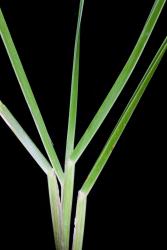- Taxon
- Gallery
Very variable, coarse, light green to greenish brown to bluish green perennial tufts to c. 70 cm, with stiff erect leaves < stems, or often scrambling and trailing to 2 m, with hanging leaves and stems drooping from thick stolons, rooting at nodes below tufts; branching extravaginal, with up to three, short, glabrous, obtuse, bract-like sheaths at base; leaf-blades persistent. Leaf-sheath light green to light brown, coriaceous, folded and strongly keeled, lateral ribs conspicuous, smooth or slightly scabrid above, rarely minutely scabrid throughout. Ligule c. 0.5 mm, a truncate usually long-ciliate rim, scabrid abaxially. Leaf-blade coriaceous, folded to flat, abaxially with prominent, thickened midrib, and numerous, distinct lateral ribs, smooth apart from prickle-teeth near tip, adaxially smooth between inconspicuous ribs; margins thickened, tip acuminate or abruptly acute, often pungent, scabrid. Culm often not far exserted beyond uppermost leaf-sheath, internodes glabrous. Panicle much-branched, branches whorled, very slender; rachis and primary branches often smooth, secondary branchlets finely, sharply, densely or sparsely scabrid or smooth, often spikelet-bearing ± throughout. Spikelets numerous, light green. Glumes subequal, narrow- to elliptic-lanceolate, acute to subobtuse, occasionally smooth throughout, or upper ⅔ scabrid; lower slightly shorter, upper (2.5)–3–4–(5) mm, 3-nerved. Lemma 3–4.5 mm, elliptic-oblong, with short crinkled hairs on lower ½ of midnerve and near base of outer lateral nerves; margins minutely scabrid. Palea 2.5–4 mm, keels finely scabrid, interkeel and flanks smooth or minutely scabrid. Callus with thick tuft of soft crinkled hairs. Rachilla c. 0.5 mm, smooth or minutely, sparsely scabrid; prolongation c. twice as long. Lodicules c. 0.5 mm, occasionally hair-tipped.
[From: Edgar and Connor (2000) Flora of New Zealand. Volume 5 (second printing).]
| Category | Number |
|---|---|
| Indigenous (Endemic) | 2 |
| Total | 2 |




